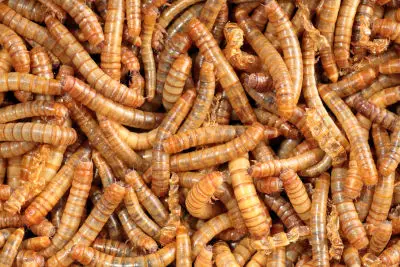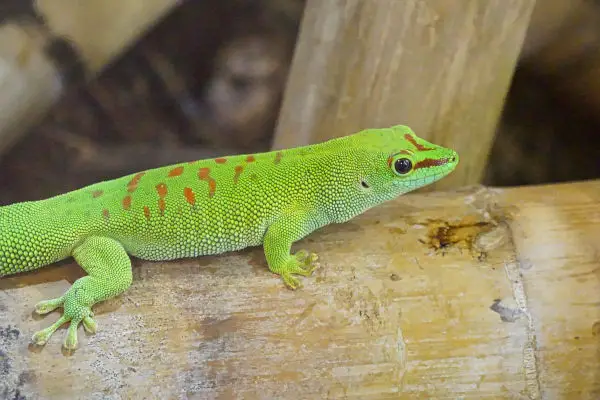Do Lizards Breathe Through Their Skin? (Impossible?)
If you have ever researched how lizards breathe, you may have assumed, or wondered if they breathe through their skin like frogs…
Do lizards breathe through their skin?
Lizards do not breathe through their skin they breathe through their lungs instead. Amphibians, such as frogs, do breathe through their skin. But reptiles, such as lizards, snakes, etc, breathe through their lungs. Some mistakenly claim that salamondrs are the exception, but they are classed as amphibians.
| Are these foods dangerous for your Beardie? | |
| Avacado? Click here to learn, from this guide, if this food is dangerous |  |
| Superworms? Click here to learn, from this guide, if this food is dangerous |  |
So, now you know. But, which animals breathe through their skin? Why can’t lizards breathe through their skin? Can lizrads breathe while running? Keep reading to get these answers, and more…
Which animal breathe through moist skin?
Amphibians, such as frogs and newts, breathe through their skin. This is possible because they have really thin and moist skin that allows them to breathe through it. This list of amphibians includes salamanders, contrary to what you may have heard, they are amphibians as well, hence the reason they breathe through their skin.
If you have ever wondered which animals breathe through their skin you now have an idea of some of them. There are also many other animals in this amphibians category, such as earthworms. But, there are more than i can list.
Can a salamander breathe through its skin?
Salamanders can breathe through their skin. This is because they are classed as amphibians. And, amphibians breathe through their skin. Because of their appearance salamanders are often assumed to be reptiles but they are in fact amphibinas.
So, if you have ever been confused as to why salamanders can breathe through their skin and other lizards, like green anolses, can’t know you know why.
Why can’t lizards breathe through their skin?

A green Gecko in a terrarium.
Lizards can’t breathe through their skin because their skin is too thick and scaley. They are built like this so they can handle their environment. However, because they breathe through their lungs they have very well developed and efficient lungs for this reason.
In case you wondered, these scales are responsible for protecting the lizards from UV rays and from the ground. When most reptiles scurry, their sensitive skin might be damaged and so these scales help them.
How do some reptiles breathe underwater?
Some reptiles that are water based, such as turtles, or frogs can bretahe underwater in one of two ways. The first way is to take oxygen in above water then go underwater with it. Otherwise, some reptiles, such as turtles have the ability to take in oxygen found in the water.
How do Lizards Breathe?
Lizards breathe through their lungs, just like us. However, they do not have a diaphragm and instead depend on their torso muscles to expand the ribs to inhale and exhale.
They flex these muscles to breathe. A study by researchers showed that most lizards exhibit unidirectional breathing.
This means that air enters through the trachea and into the lungs of these lizards. However, it is not exhaled back as in humans. Instead, it loops back into another airway from one bronchus to another.
Lizards have many bronchi in their lungs, up to a dozen in the count. There is one primary pathway with many another branching off of it. The airflow from one airway to the other improves oxygen extraction.
Can Lizards Breathe While Running?
It has been commonly observed that most lizards cannot breathe while they run. This is because lizards run by twisting and flexing their bodies sideways. These muscles help lizards move forward. However, these muscles also control how the ribs expand, allowing the reptile to breathe.
Since lizards rely on these same muscles for respiratory and locomotory functions, they cannot do both at the same time.
The sideways flex compresses one lung and expands the other, resulting in the passing of the same stale air from one lung to the other. So, most lizards have to stop after running a while to catch their breath and recover the oxygen in their blood.
Some lizards such as the monitor lizards use a technique called a ‘gular pump’. With a gular pump, they use sacs in their throat to pump in the air while their torsal muscles are busy running.
This allows the air to enter the lungs even when they run and the lungs cannot expand. This is why monitor lizards are much more aerobic and faster than common lizards.
Can Lizards Hold Their Breath?
Yes, most lizards can hold their breath for a long period of time. This is because they breathe by expanding their torso muscles.
These muscles are being used to run as well. Lizards cannot use both of these muscles at the same time. So, while running lizards need to hold their breath.
Furthermore, they can easily hold their breath underwater as well. Some monitor lizards, that many have wondered if this lizard can really swim, exhibit unidirectional breathing which allows them to store and trap air in their lungs until all the oxygen is extracted out.
This further enhances their ability to hold their breath as they can easily survive off of the excess oxygen in their lungs.
Do Lizards have Lungs?
As discussed previously, lizards rely on their lungs to breathe. Their lungs contain about a dozen bronchi each of which extracts oxygen efficiently. The main pathway is branched off into various bronchi.
This provides the lungs with a greater surface area for the exchange of gases. However, not all lizards have several bronchi. In fact, most primitive lizards have only two bronchi which do not further divide at all.
Their lungs are hollow sacs with internal folds for a higher surface area.
The expansion is aided by the movement of the ribs. Some lizards even use the anaerobic mechanism of breathing during apnea.
The gaseous exchange takes part in the cranial part and the caudal part stores the lungs.
How Long can Lizards Hold Their Breath?
Most lizards can hold their breath for a very long time. When submerged in water, most lizards can hold their breath for 24 minutes!
Researchers have concluded that unidirectional breathing allows more oxygen to be extracted from the inhaled air. This means that one gulp of air is enough to last a long time, which is why it’s easier for lizards to hold their breaths for so long.
They can also survive in situations with lower oxygen levels since they can maximize the amount of oxygen they get.
Can Lizards Breathe Upside Down?
You might often find that lizards go to sleep if they are turned upside down. Well, the truth is that they are knocked out since they cannot breathe while upside down.
This is because they do not have a diaphragm separating their lungs and lower abdomen. When they are upside down, their stomachs start pressing on their lungs, which makes it harder to inhale.
This makes it harder for them to breathe and results in suffocation. Also, their torso muscles hang around and are weighed down by the rest of the body. This makes it harder for lizards to push these muscles and breathe.
This usually causes a trance-like state which can eventually result in death.
Do Lizards Fall Asleep If You Put Them On Their Back?
When you put a lizard on its back, it seems like it goes to sleep. In fact, this state is not sleeping, it is a state of trance called Tonic Immobility. This is referred to as a state of temporary immobility where the animal acts like it is dead. This is because of two reasons:
When they are put on their back, it presses a lot of weight on their lungs. They have no diaphragms, so their lungs tend to collapse and their torso muscles can no longer help expand the ribs to inhale air. This results in them suffocating. The lack of oxygen can lead to a trance-like state to ensure their metabolic processes are slowed down.
However, this is not the only reason. Another reason is that they might feel threatened or vulnerable. They enter into a state of stupor to discourage their predator.
The predator might think it is dead and leave it alone. And as soon as it does, the lizard pops back up and runs away.
Do Lizards Have Diaphragms?
As I have already discussed before, lizards and most reptiles do not have a diaphragm. A diaphragm is a thin layer of muscles inside the body that separates the heart and lungs from the stomach and everything beneath it. It is the expansion and contraction of the diaphragm that allows us to breathe.
Lizards, however, do not have a diaphragm, and instead, rely on their axial muscles to breathe. These muscles are responsible for expanding the ribcage. However, some lizards such as the Tegu Lizards possess a proto diaphragm that separates the lungs from the rest of the body parts.
However, this is its only purpose as it does not expand or collapse for breathing. It does allow for larger inflation, but that’s it!
Why Do Some Lizards Play Dead?
When some lizards are put on their back against their wishes, they might end up thinking they are being attacked. They are in a vulnerable situation where they might not be able to run from any potential predators.
So, when they are put on their back, they often feign to be dead to discourage their predator from eating them since most predators will not engage in eating dead prey. This is called Tonic Immobility.
This immobility condition ensures they do not respond and do not show any signs of movement. One reason could be that most predators prefer live prey while another reason could be that these predators rely on movement from the prey to detect them.
However, most lizards play dead on their back because their lungs collapse and their system enter a catatonic state. This results in a lower respiration rate. These lizards then enter a comatose state to preserve oxygen and slow down their metabolism.
Conclusion
Well, there you have it! Lizards do not have a diaphragm which results in many breathing problems. You may also be wondering, can lizards hear?
I encourage all my readers to do their own research on the topic and find out as much as they can. The more educated you are, the better you can care for your pet.